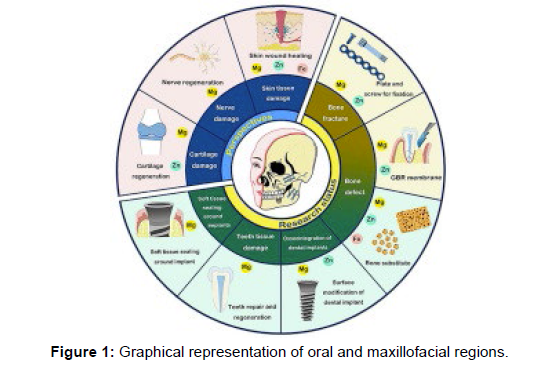Imaging on Oral and Maxillofacial Regions
Received: 02-Feb-2023 / Manuscript No. roa-23-90057 / Editor assigned: 04-Feb-2023 / PreQC No. roa-23-90057 (PQ) / Reviewed: 18-Feb-2023 / QC No. roa-23-90057 / Revised: 21-Feb-2023 / Manuscript No. roa-23-90057 (R) / Published Date: 28-Feb-2023 DOI: 10.4172/2167-7964.1000426
Image Article
The oral and maxillofacial regions have numerous tissue types and intricate anatomical structures that serve essential health and aesthetic purposes. Bioactive materials with the potential to treat oral and maxillofacial diseases include biodegradable metals (BMs).
The current state of research on BMs for oral and maxillofacial applications as well as potential future research directions are outlined in this summary. Bone fracture fixation systems based on Mg- and Zn based BMs, as well as guided bone regeneration (GBR) membranes, are the subject of in-depth discussion. Clinical translation holds great promise for Zn-based BMs with superior mechanical properties for GBR membranes and a moderate degradation rate [1,2].
Due to their insoluble degradation products and relatively slow degradation rate, Fe-based BMs severely restrict their clinical application. Additionally, we suggested BMs containing hydrogels for the regeneration of cartilage, soft tissue, and nerves as well as 3D-printed BM bone scaffolds, surface modification for BM GBR membranes, and other potential future research directions for BMs in the oral and maxillofacial regions. The development of BMs in the oral and maxillofacial regions has made progress that can be used for clinical translation in the future (Figure 1).
References
- Lange TS, Bielinsky AK, Kirchberg K, Bank I, Herrmann K, et al. (1994) Mg2+ and Ca2+ differentially regulate beta 1 integrin-mediated adhesion of dermal fibroblasts and keratinocytes to various extracellular matrix proteins. Exp Cell Res 214: 381-388.
- Lange TS, Kirchberg J, Bielinsky AK, Leuker A, Bank I, et al. (1995) Divalent cations (Mg2+, Ca2+) differentially influence the beta 1 integrin-mediated migration of human fibroblasts and keratinocytes to different extracellular matrix proteins. Exp Dermatol 4: 130-137.
Indexed at, Google Scholar, Crossref
Citation: Gupta S (2023) Imaging on Oral and Maxillofacial Regions. OMICS JRadiol 12: 426. DOI: 10.4172/2167-7964.1000426
Copyright: © 2023 Gupta S. This is an open-access article distributed under theterms of the Creative Commons Attribution License, which permits unrestricteduse, distribution, and reproduction in any medium, provided the original author andsource are credited.
Share This Article
Open Access Journals
Article Tools
Article Usage
- Total views: 943
- [From(publication date): 0-2023 - Mar 13, 2025]
- Breakdown by view type
- HTML page views: 784
- PDF downloads: 159

